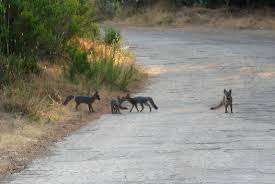 |
| Tiger lion big cat monster maneating ogre or best friend in nature (dumpaday.com) |
 |
| One-eared kitten of B-337. Is there contamination in the environment leading to limb loss? |
 |
| The dam/bridge over Hahamongna watershed. |
Recently, under the Angeles National Forest, we were with the Buddhist-Shaman Gabbies walking in the Pasadena foothills above the Rose Bowl, site of that famous New Year's Day football game. We spotted a bobcat. It had rained, and the Hahamongna basin was marshy. Ducks were schooling in a pool, and debris was cast up on shore in full view of JPL.
.
 |
| Tongva, Hahamongna (Edward S. Curtis) |
Who knows what NASA is up to in there, but out here the big cat strolled by turning every so often. We climbed the dam/bridge, and others spotted the cat using a floating debris catchment as a causeway. We followed the cat into the brush, and it turned back on us, stalking us until we caught sight of it in the shadow of the setting sun. There were mushrooms in the trees, and the white sage, coyote brush, and mallow were thriving. Dog walkers and people on horseback were not alarmed that a big cat was in the area. One man reported that he often spotted the feline. Humans are safe around bobcats, but small dogs on their own beware. The cats prefer rabbits, squirrels, birds, and small prey.
Biologists track 3-legged bobcat and her 1-eared kitten in Santa Monica Mountains
 |
| Biologists track 3-legged bobcat, B-337, and her 1-eared kitten in Santa Monica Mountains, caught on camera in January 2015 National Park Service (National Park Service/scpr.org). |
(SCPR) Biologists are tracking another wildcat in the Santa Monica Mountains -- this time it's a three-legged bobcat with a kitten to feed.
Biologists aren't sure why the bobcat, dubbed B-337, is missing a leg, whether by genetic defect or injury, but [it's alarming that] her kitten, B-336, also happens to be missing an ear, according to a blog post from the National Park Service.
B-337 kept showing up on camera traps before finally getting caught in a cage trap and collared, NPS communications fellow Zach Behrens writes.
(National Park Service) B-337, or Bobcat 337, is released after being captured by National Park Service researchers on the western end of the Santa Monica Mountains. This female bobcat has three legs but it does not appear to be hindering her ability to care for herself and at least one kitten. (More: nps.gov/samo/blogs)
Bobcats and other wildlife face a number of threats in the area, from other animals to roads and even rat poison. Such threats have limited the genetic diversity of bobcats and mountain lions, which have often had to resort to inbreeding.
But both bobcats appear to be doing fine despite their handicaps, according to biologist Joanne Moriarty.
"Bobcats catch live prey, so that means she's managing to hunt with one front leg -- and doing it well enough to feed herself and her kitten," Moriarty says in the post.
Moriarty said preliminary data suggest B-337's range may be smaller than the roughly one square mile averaged by other female bobcats. She said they're now analyzing blood samples to learn more about the cats. More
- Dead Pt. Mugu mountain lion ingested rat poisons
- Bobcat trapping ban belies hunting tradition, management
- California bans bobcat trapping in narrow decision
- MAP: LA freeways, rat poison affect bobcats' genetic diversity
- VIDEO: Health improving for mountain lion P-22 (update)
The California Canines of the Channel Islands
KPCC FM (scpr.org/news, Feb. 12, 2016)
The U.S. Fish and Wildlife Service said in an announcement that it plans to remove from the Endangered Species Act list: the San Miguel, Santa Rosa, and Santa Cruz Island subspecies, all native to California's Channel Islands.
Wildlife officials and conservationists have worked for years to boost the fox population, in part by eliminating or controlling predators and disease, according to the wildlife service.
“Part of the wonderful story about this recovery is the entire ecosystem was put out of whack through primarily DDT being put into the environment,” Steve Henry, field supervisor of the U.S. Fish and Wildlife's Ventura office, told KPCC.
 Henry said that DDT diminished the natural population of bald eagles on the islands. Along with the DDT, non-native species were introduced, like the golden eagle... More + SLIDES
Henry said that DDT diminished the natural population of bald eagles on the islands. Along with the DDT, non-native species were introduced, like the golden eagle... More + SLIDES
 |
| Buddhist novice loves puppy. |
Channel Islands foxes have made the fastest recovery for any mammal listed on the endangered species list, U.S. wildlife officials said Friday [Feb. 12, 2016].
 |
| Doggies love yoginis. |
“Part of the wonderful story about this recovery is the entire ecosystem was put out of whack through primarily DDT being put into the environment,” Steve Henry, field supervisor of the U.S. Fish and Wildlife's Ventura office, told KPCC.
 |
| "Take Two" with A Martinez and Alex Cohen (KPCC/SCPR.org, Feb. 19, 2016) |






















































































































































































































































No comments:
Post a Comment